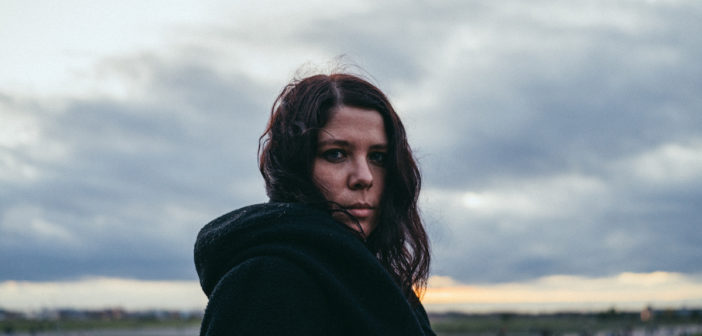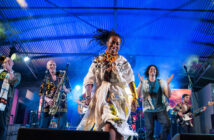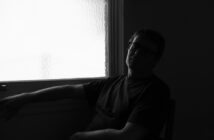Judith Hamann is a cellist and performer/composer from Melbourne, now based in Berlin. She has worked with artists and ensembles including Australian Art Orchestra, Oren Ambarchi, Dennis Cooper, ELISION ensemble, Jürg Frey, Sarah Hennies, Graham Lambkin, Alvin Lucier, Toshimaru Nakamura, The Necks, Áine O’Dwyer, Stephen O’Malley, Eliane Radigue, Wadada Leo Smith, Ilan Volkov, Tashi Wada, Manfred Werder, La Monte Young and Marian Zazeela, and John Zorn. Judith is a member of Golden Fur, Hammers Lake, The Argonaut String Quartet, and has duo projects with Rosalind Hall, Anthea Caddy, and Lori Goldston.
She has just released two new albums on Blank Forms, Shaking Studies and Music for Cello and Humming. Blank Forms suggests “Shaking Studies‘ harmonic investigations allude to a responsive, intuitive mode of convulsive sounding that emphasizes micro and macro pulsing, including tremors, vibrato, wolf tones, and complex partial activity.” It’s an intriguing highly textural work that marries a unique conceptual approach with extended technique.
Music for Cello and Humming meanwhile features two pieces for cello and humming written specifically for Hamann by composers Sarah Hennies and Anthony Pateras, alongside Hamann’s own “Humming Suite” and “Study for cello and humming. Again it’s intruiging and a little weird, yet hearing humming elevated as its own musical instrument is nothing short of fascinating. With two bold new releases and such a unique forward thinking approach to her instrument, we took the opportunity to ask her about some of the music that has moved her this year:
Things that helped
For my Cyclic Selects, I made a list of things I’ve listened to this strange year which have helped me cope and survive, made me happy, helped me feel less alone, helped me feel my feelings, brought me companionship, made really rough spots bearable. It’s a very personal list, it’s bit like wearing my lockdown pyjamas in public, but each of these things has helped me in some integral way this pandemic year. Maybe some of them will help you feel better when things are weird too?
Annette Peacock – I Have No Feelings (ironic records)
I’ve always enjoyed Annette Peacock’s music but at more of a safe distance, never too entangled. However, something happened this year, a sort of clicking into place, specifically with the 80s records on her own label and now I really just can’t recommend these enough for a strange difficult year. I find them in turn so familiar and so strange. Each time I listen to I Have No Feelings, it’s like some sort of vaguely disorienting labyrinth where the way is familiar but the walls have moved ever so slightly, things get turned around, catch in your throat, like ‘I don’t remember this door being here…’ those sorts of feelings. I love the way this music feels so close, an almost physical proximity, and then in the next breath the walls have blown out to a massive space. Maybe it’s not a labyrinth but a house, where one phrase is like moving from a crawl space to a cathedral under the same roof.
It is also just so, so beautiful, each of the songs on this record are a masterclass in how to construct and phrase, to really turn a melody like a ceramic on a potters wheel. I forget and then remember with the crashing in of a synth string sound the fact she constructed these complete universes alone with a piano and a moog, and from time to time those melodies just land, like a goddamn punch to the chest.
Black Sabbath – Paranoid (Vertigo)
Shortly after the borders closed and the first lockdown kicked in, I’d arrived at an artist residency in Finland. I was a total mess the whole month of March really, and I was really, really rueing that I had not brought more books with me. In the laundry, where a shelf housed debris from previous residents there were a couple of books in english, including How Black Was Our Sabbath: An Unauthorized View from the Crew. Reading that got me into a very enjoyable phase of digging in to the first three Black Sabbath records, which are just so great and I hadn’t listened to them for ages. I spent a lot of low skied dark afternoons staring out the windows towards the sea listening to this record. It was also basically an impossible exercise to choose just one record couldn’t we think of the first three Sabbath records as a ‘body of work’..?!
id m theft able – A tuba by the falls (with a microphone in it) at dusk, April 19th 2020 (self released)
There was a distinct phase this year where I couldn’t listen to any sounds which were (how do I explain it?) ‘conventionally’ produced by instruments or voices, what we might commonly refer to as “music” I suppose. Suddenly songs, most music I love, I just couldn’t. It was like I became allergic to melody, harmony, rhythm, tones. However, I found a great deal of joy in listening to other kinds of sounds, in the field recording series my friend BJ Nilsen was making around Amsterdam, of people’s domestic spaces via various lockdown recordings. I think maybe there was probably almost a whole month where this sort of thing was the ONLY thing I listened to, and anything even approaching a song just made me feel panicked for reasons I still don’t really understand. It was really strange, I’d never felt this kind of aversion to “music” before and I wonder if maybe I needed a connection to the ‘world’ and real things and places very badly.
These ‘A Tuba…’ videos by id m theft able I find so satisfying as sounds, but also they’re just gorgeous things to watch as well. They were things that really helped me through that patch this year, and luckily there are heaps of them (other favourites include ‘A Tuba in the Snow (with a microphone in it).’
Toshiya Tsunoda – Extract From Field Recording Archive (ErstPast)In the same spirit, I also listened to this box set of Toshiya Tsunoda’s work a lot this year. It’s such incredibly rich and beautiful listening: so detailed, such a wonderful way of pivoting and reframing a sense of being in space and how spaces might speak. I listen to and for these kinds of sounds generally, you’ll often find me rapt with fixed attention at various fans, vents, underground carparks, ventilation systems. This box set captures the lives of those things so wonderfully, I especially love the recordings from inside objects, giving us the vantage point of other contained self contained yet porous universes, like on the second CD: The Air Vibration Inside A Hollow. When I was deep in my ‘music allergy’ phase I really loved these spaces, these alternative perspectives for listening, I could still just listen to this whole box set forever really.
Maybe all of this had to do with questions which Tsunoda himself says his work positions itself in relation to, that of the difference between ‘space’ and ‘place.’ I think perhaps being so adrift in that whole-life-capsizing-sort-of-way, to listen to spaces like this was something that really helped me make it through to the northern hemisphere summer.
Tirana Ensemble – Chants Polyphoniques d’Albanie (Iris)
I had another phase after the music allergy cleared a bit, where I only wanted to listen to voices, I guess maybe the isolation? I was listening to all kinds of vocal music, some from Mexico, indigenous Taiwanese music has also featured, but this particular recording of Albanian iso-polyphonic singing has really stayed with me and I still listen to it fairly often. I think maybe Ilan Volkov’s At Home radio show got me onto this particular recording? The kind of closeness and intimacy of the voices is just so beautiful, there really feels like there is so much love for this way of sounding together in this ensemble.
Maybe this makes me feel better because, however misplaced my reaction to it probably is, there is a sort of sensation of real love which carries through these recordings, it’s almost palpable, like you could touch it. I was trying to explain this feeling that I have about these recordings to someone, and the closest I could get is like when someone you love wraps a giant towel around you when you get out of the bath. I’m sure there’s some kind of psychoanalysis that could be drawn from this statement re: isolation and human intimacy but it’s probably much more rewarding to just listen to the music.
Don Cherry and Terry Riley- Köln – February 23, 1975 (modern silence)
I’ve listened to this SO many times this year and keep coming back to it. Somehow I had never heard this before the pandemic, but it always seems to be exactly the right thing for whatever my general default headspace is this year. If I want to listen to something but I’m not sure what, this always works. It’s become a kind of sonic equivalent of vegemite toast, the thing that always helps. The interplay between Don Cherry’s trumpet and Riley’s keyboard work is just incredible, and it seems to never fail to make me feel better. Essential.
Eliane Radigue – Feedback Works (Alga Marghen)
Eliane’s music is a sort of lodestar for me, something that no matter how messy I’m feeling always shows me something, gives me something, teaches me something. This year I made a lot of work with feedback, something which felt in some senses as strange as working with something utterly untameable, and I love that about feedback as a material: being so completely antithetical to constructs of musical mastery: it’s something you have to live with, listen to, respond to with a lighting fast physicality, you have to alter your body to work with feedback, to the pace that’s like that of a life model holding a pose for a long time or someone training a hawk: you have to become invisible and present simultaneously.
After spending several months of this year playing feedback with washing baskets and pots and bowls and buckets, I am just in awe of the work that Eliane made with feedback. There’s a deep sense of respect for sound and space and electricity as collaborators here, a sense of real love and care for these sounds and their unfolding. Eliane has for so many years been such a guide, and this collection, while not perhaps the typical works people think of when her name floats into a conversation, are so magical, especially Vice-Versa.
Hilda Dianda – Tape Music – Después del silencio
I only came across Hilda Dianda’s music quite recently, and I think it’s also such a shame that her work isn’t mentioned in the same breath as any of the, say, European women electronic music pioneers. Perhaps because her compositional practice drifted away from tape and electronic music over time. Her work has this sense of breathing to it, that I feel resonates with and echoes a lot of the work I’ve been trying to make this year with electronics and feedback. I think it’s incredibly beautiful, it is music that still catches me by surprise, still turns to unexpected spaces and forms. It’s been so wonderful to listen to her work, but also to respond to it, to treat it as something bordering on instructional, in terms of choices, these nebulous forms sliced through with hard edged objects. There’s so much shape and body to the sounds she’s using and how she’s using them. I’m currently trying to track down some more of her work, including her string and tape scores. It’s been so lovely to meet this person’s music the last little while.
Angel’s music has been on fairly consistent rotation in my listening for a while now, but there’s just been so much she and her community have given me this year, so much we should all be grateful for really. This recent record ‘LIVE’ is just bursting with energy, it’s so utterly alive, it’s so direct, it’s so electric. It makes me miss live music so much.
The kind of work that Angel is making as an artist and a band leader is so important, and exactly who we should be listening to, and for, right now on so many levels. I’ve washed up in Berlin for now so this latest record is particularly resonant in terms of how broken things are here in Germany, how much people can’t see. We need to listen to Angel in her role as a performer, as an activist, as a black woman artist, as a community builder, to what she it doing in terms of showing us how music might be used for imagining and creating non-hegemonic systems and for dismantling oppression, for calling out institutional racism, but most of all for the sheer fucking joy in her playing, the joy between her and her band as they fill a space with music that’s just crackling with being alive, the defiance in that. https://www.facebook.com/watch/?v=264602741387967
On a really personal and selfish music making level, every time I listen to her record The Oracle and remember it was made on a phone it refocuses my energy and thinking about the kind of recorded work I’ve been making this year with really limited resources, that if the music and the energy and the work itself is enough, is alive enough, it can leap over those audiophile shame nets that tend to catch me real hard and find its way to the listener, it can still do its work, it can be what it is. This was something that really helped me as well: a reminder of what’s important as a performer, as someone who ‘plays.’
Also my friend Deacon Julian Otis is in Angel’s band Tha Brotherhood and I wish he had a record out so I could also put his music here, but this is close!
Claire Rousay – It was always worth it (Longform Editions)Claire has had such a prolific year of music making and releases, so it’s hard to choose just one release. I really loved her AMPLIFY 2020: Quarantine piece, a totally brilliant ‘confessional’ piece ‘im not a bad person but…’, and her Second Editions record ‘Both,’ but am choosing to play this one because while it’s also in that vein in some senses, and maybe it’s the string player in me that makes me extra won over by this one, but it’s just so heartbreaking. It makes a space through Claire’s uncanny ability to make such compelling work from this sort of examination of ‘self perception’ for all our own heartbreaks and losses, our mistakes, but also our friendships and loves and curiosity. Maybe that’s part of what Claire’s music does: they are solo recordings that somehow make collective listening spaces for feeling, and in this case, (I feel) one for grieving. In that sense I think the descriptor ‘emo-ambient’ which hovers over this work is totally apt: it carves out a similar thing to that intense, almost teenage, way of a song making a space to really feel those feelings. It can also be a diagnostic tool, a way of making sense of things internal and external.
Marja Ahti – Vegetal Negatives (Hallow Ground)
Marja Ahti was someone who really helped me this year, with her music, and as a human. In fact, I guess we became friends and collaborators during the first wave lockdown. I never imagined that I’d get to know and like someone so much without in-real-life interaction during one of the most isolated periods in my life, I’m very lucky. We worked together on a project for the Cafe Oto digital label TakuRoku, and having Marja’s sounds and ideas and music woven into my own life has been such a beautiful thing this year, so precious and so rich.
I have listened to her sounds a lot now obviously, but still find it so rewarding to circle back around to this earlier solo record, the musicality and beauty in this braiding together of domestic sounds and electronics, the detail of their construction, the arcs that these pieces trace. Marja’s music always serves as a gentle reminder of how to turn my attention, how to listen, how to hear anew these interior spaces we have all spent so much time in this year: the magic in the kettle boiling, the preciousness of going for a walk.
Beverly Glenn Copeland – Keyboard Fantasies (Atlast Records)
When I haven’t been isolated on an island in the Baltic Sea etc., I’ve ended up in Berlin hanging out with my friend who is a single mum and her 2 1/2 year old a bunch. I take care of my quasi-adopted little mate quite a bit, and our listening favourite for this strange year is definitely Beverly Glenn-Copeland. This record never fails to calm us both down, and is the perfect soundtrack for some train set assembly, blanket fort building, or slow dancing. It’s also just really wonderful, being-alive-affirming music outside of hanging out with the under five crowd obviously. We should all be very grateful we live in a time when his work has been reissued and is here to make us feel better.
Beverly and his partner hit some serious strife earlier the year and nearly ended up homeless due to covid cancellations, but it seems that many many people have a lot of love for this music and supported them with raising funds to help them organise stable housing. I can’t emphasis enough the difficulty of being a musician formerly dependent on touring to survive right now, especially when it intersects with factors such being bla(c)k, queer, trans*, so while Beverly might be ok for now, please check in on music people in your communities, make sure they are safe and ok.
Music For Cello and Humming and Shaking Studies are out now on Blank Forms. You can find them here.




